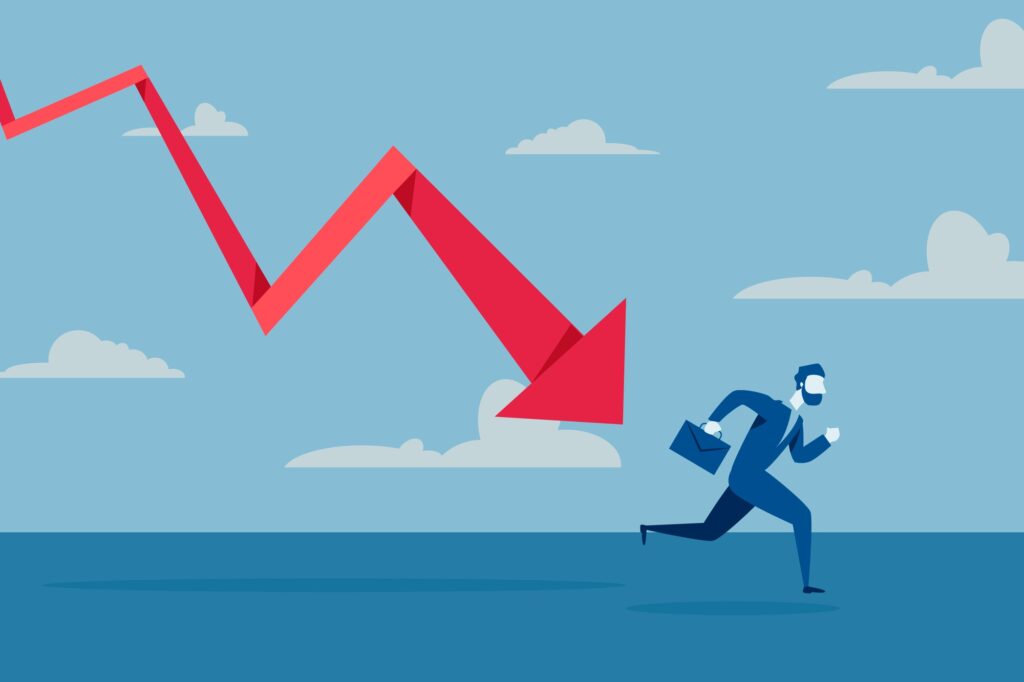
What are Financial Crises?
During a financial crisis, the prices of assets drop sharply, businesses and consumers can’t pay their bills, and financial institutions run out of money. People often think of a panic or a bank run when they hear “financial crisis.” During a panic or a bank run, investors sell their assets or take money out of savings accounts because they fear their assets’ value will go down if they stay in a bank.
Other scenarios classified as a financial crisis include the collapse of a speculative bubble economy, a stock market crash, a sovereign default, and a currency crisis. A financial crisis may affect banks or the whole economy, a region’s economy, or economies worldwide.
What triggers a financial crisis?
There could be more than one reason for a financial crisis. In general, a crisis can happen when institutions or assets are overvalued, and it can get worse when investors act irrationally or like sheep. For example, a fast series of selloffs can lead to lower asset prices, making people want to sell their assets or take out a lot of money from their savings when rumors of a bank failure occur.
A financial crisis can be caused by systemic failures, unexpected or uncontrollable human behavior, rewards for taking too much risk, a lack of regulation or a failure of regulation, or contagion, which is when problems spread from one institution or country to the next like a virus. If nothing is done to stop it, a crisis can lead to a recession or depression if it is not fixed. Even if steps are taken to stop a financial crisis, it could still happen, get worse, or get worse faster.
Instances of Financial Crisis
Financial crises don’t happen very often, but they have happened as long as there has been money. Here are some well-known financial crises:
Tulip Mania (1637).
Some historians say that this mania didn’t have much effect on the Dutch economy and shouldn’t be considered a financial crisis. However, it happened at the same time as an outbreak of bubonic plague, which greatly affected the country. Given this, it is hard to say whether the crisis was caused by too much speculation or the pandemic.
Credit Crisis of 1772.
After a time when credit was growing quickly, this crisis began in March or April in London. Alexander Fordyce, a partner in a big bank, lost a lot of money when he borrowed the East India Company shares and then ran to France to avoid paying back what he owed. Panic caused a rush on English banks, and more than 20 big banks either went bankrupt or stopped paying their depositors and creditors. A lot of Europe was affected by the crisis very quickly. Historians say this crisis led to the Boston Tea Party, a protest against unpopular tax laws in the 13 colonies. The protests that followed led to the American Revolution.
Stock Crash of 1929.
After a time of wild speculation and borrowing money to buy shares, the stock market crashed on October 24, 1929. It caused the Great Depression, which lasted for over a dozen years and affected the whole world. It had a much bigger effect on society. One thing that led to the crash was a huge oversupply of commodity crops, which caused prices to drop sharply. As a result of the crash, many new rules and tools for managing the market were put in place.
1973 OPEC Oil Crisis.
In October 1973, members of OPEC put in place an oil embargo against countries that helped Israel during the Yom Kippur War. By the time the embargo was over, a barrel of oil had cost $12 instead of $3. Since modern economies depend on oil, higher prices, and uncertainty led to the stock market crash of 1973–74. From January 1973 to December 1974, a bear market lasted, and the Dow Jones Industrial Average last about 45% of its value.
Asian Crisis of 1997–1998.
This crisis began when the Thai baht fell in value in July 1997. The Thai government had to let the baht float because it didn’t have enough foreign currency to keep it tied to the U.S. dollar. The result was a huge drop in the currency’s value, which affected most of East Asia, including Japan, and a huge rise in the debt-to-GDP ratio due to the crisis, financial regulation, and oversight.
The 2007-2008 Global Financial Crisis.
Since the Stock Market Crash of 1929, this financial crisis has been the most catastrophic thing to happen to the economy. It began with a crisis in subprime mortgage lending in 2007, and when investment bank Lehman Brothers failed in September 2008, it turned into a global banking crisis. Huge bailouts and other plans to stop the damage from spreading didn’t work, and the world economy went into recession.
COVID19 Pandemic.
In February 2020, a worldwide stock market crash began. From February 20, 2020, to March 23, 2020, the S&P 500 fell by more than 30%. This happened because of the COVID-19 pandemic, which made many people scared and uncertain about the future of the world economy. Even though it was bad and affected the whole world, markets, and national economies bounced back quickly. By early April 2020, the S&P 500 had started a clear rise, and by August 2020, it had passed its high point before the pandemic.
Conclusion
A financial crisis happens when the prices of assets drop sharply, businesses and consumers can’t pay their debts, and banks run out of cash. A financial crisis can be caused by several things, such as systemic failures, unexpected or uncontrollable social interactions, incentives to take too many risks, a lack of regulation or regulation that doesn’t work, or natural disasters like pandemic viruses.
